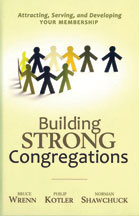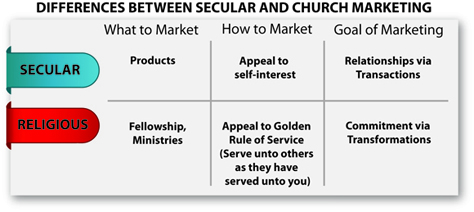
By Ronald E. Keener
 The use of marketing within the church is still seen as controversial, says one of the authors of Building Strong Congregations (Autumn House Publishing). Bruce Wrenn says, “It depends on whom you ask. Some critics will always be opposed to the use of marketing because they find its function at odds with the spiritual life of the church. Other critics might be won over if their opposition is based on a misunderstanding of what marketing really is, or if they mistakenly believe we are proposing it be used for all components of a church’s mission. We are careful to recommend its use only where appropriate in church settings.”
The use of marketing within the church is still seen as controversial, says one of the authors of Building Strong Congregations (Autumn House Publishing). Bruce Wrenn says, “It depends on whom you ask. Some critics will always be opposed to the use of marketing because they find its function at odds with the spiritual life of the church. Other critics might be won over if their opposition is based on a misunderstanding of what marketing really is, or if they mistakenly believe we are proposing it be used for all components of a church’s mission. We are careful to recommend its use only where appropriate in church settings.”
Wrenn is professor of Christian ministry at Andrews University, Berrien Springs, MI, and wrote the book with marketing expert Philip Kotler and church consultant Norman Shawchuck. Dr. Wrenn responded to questions from Church Executive.  This is the full interview; an excerpted version appeared in the November 2012 issue of Church Executive.
This is the full interview; an excerpted version appeared in the November 2012 issue of Church Executive.
Is the use of marketing by religious organizations controversial?
It depends on whom you ask. Some critics will always be opposed to the use of marketing because they find its function at odds with the spiritual life of the church. Other critics might be won over if their opposition is based on a misunderstanding of what marketing really is, or if they mistakenly believe we are proposing it be used for all components of a church’s mission. We are careful to recommend its use only where appropriate in church settings.
Can or should religious institutions and churches be marketed?
We believe religion, that is, Christianity, shouldn’t, and indeed can’t, be marketed. But a church and its ministries can and should be marketed. We affirm its use for churches because we see marketing as enhancing the achievement of those parts of mission that are concerned with serving people’s legitimate needs—what Rick Warren identified in the Purpose Driven Church as fellowship and ministry. Marketing involves the deep understanding of people’s needs and the development of need satisfying services, exactly what churches are trying to achieve by fostering fellowship and offering ministries as part of their mission. Attracting other believers without a church home to join your congregation is also part of the “can and should” territory of church marketing.
When should a large congregation begin to consider staffing for the marketing function? What is a threshold for this function?
The first thing that congregations of any size should realize is that they are already doing marketing if they are trying to serve the needs of people inside or outside of their congregation. So, staffing may merely consist of the church staff, volunteer or paid, learning how to do it better. Also, because marketing is concerned with serving the needs of others, we all want to become “marketers”, and keep the commandment to “do unto others.” In one sense, staffing the marketing function is merely helping congregants become more committed to understanding and serving people in need.
A case can be made, however, for the strategic planning team to create a marketing plan as part of the planning process, and assign responsibility for its implementation to a specific individual.
You write about the “responsive congregation.” What is meant by that?
Responsiveness can be thought of as a strategic trait of being able to respond to environmental opportunities or threats, but we are using that term here to refer to the behavior Christ was talking about in Matthew 25. I’m referring, of course, to when Jesus said that when we respond to people in need by helping them he feels as though he was the recipient of your help. That is the kind of “responsive congregation” we are promoting, and for which marketing can help become more effective and efficient in achieving that part of their mission.
Some pastors are frightened by the results of surveying parishioners. How can surveying opinions be properly handled?
I suspect the idea is intimidating to many if not most church leaders. I prefer to counsel about the desirability of understanding before we plan or act, rather that stipulate the need for surveying. It’s hard to imagine a situation where you wouldn’t want to understand before you made or implemented a decision. “Understanding” can happen through many methods, surveys being only one example. If we see the merits of first understanding, we will be open to choosing the most appropriate method to acquire that understanding. In the college marketing research courses I teach we learn the importance of matching the tool to the task. Surveys may or may not be the method of choice.
How can congregations use social media to market effectively?
Churches need to fit their use of social media within the larger communication strategy known as Integrated Marketing Communications, or IMC. We want to think in terms of coordinating all our means of communication—our Facebook page, websites, YouTube videos, Podcasts, Flickr page, Twitter messages, even our worship bulletin and the sign in front of our church and all other message media—to provide consistent, well planned and engaging messages about who we are. Using social media is a given, but we need to think beyond Facebook; we need to integrate all our communication methods to contribute to achieving our mission.
We should also remember, however, that online relationships are a complement to face-to-face relationships, not a substitute. This is particularly true for social institutions like churches. People go to Facebook to hear from their friends about what congregation they’ve found is “home’ for them. Those friends haven’t found a church home based on an online relationship. So, yes, you absolutely want to use social media as part of your IMC strategy. Just don’t have unreasonable expectations about its role in helping you achieving your goals.
Are there specific marketing implications for multi-site churches?
Yes, there are strategic decisions that must be made for multi-site churches. The primary decision concerns your desire to either increase the core church’s reach to the same segment of the population (what we would call a market penetration strategy), or use the branch sites to appeal to a different segment of the population than the core church (what we call a market development strategy). That decision will have profound implications for all other decisions about church structure, programs and ministries, worship services, etc.
Other than Willow Creek and Saddleback, what churches have strong marketing? What few things make them more effective?
Actually, some of the “best practices” in church marketing are not necessarily found in the largest churches. One of the unique aspects of our book is the inclusion of a CD bound into the back cover that includes links that you can click on to get to hundreds of sites of value to church marketers. Several dozen of these are devoted to discussion of best practice strategies and tactics being used by church marketers at churches of all sizes. The point is that we can all learn from one another, and need to be open to new ideas coming from any source, but we need to be wary of just trying to copy some other church’s success formula.
We’ve all experienced, or seen, the follies that can come with trying to imitate management practices used by secular organizations or other churches without due diligence given to whether they are appropriate for our organization. In fact, it is sometimes the case that secular businesses should be looking to churches for guidance. I once wrote an article entitled “What Business Can Teach Religious Organizations about Customer Service.” I think it’s time I wrote an article entitled “What Churches Can Teach Businesses about Building a Loyal Committed Customer Base.”
What is branding when applied to a church?
Branding provides a valuable benefit to consumers by helping to simplify an increasingly complex decision making process. Brands signal a certain known quality to us based on past experiences that reduces risk and decision making time. These benefits are present no matter what is being branded.
I recently was talking with a church marketer about how marketing is sometimes defined as removing the barriers to exchange, and that he might be faced with barriers of knowledge, motivation and trust that stand in the way of engaging in exchange with the audience he was trying to reach. Branding can be an effective means of breaking through barriers such as these. I see the most successful churches as having a well-established “corporate” brand, plus scores of individually branded ministries, events, and programs. My guess is that they are giving a lot of attention to continuous improvement of their branding strategies and tactics.
Christianity is on the receiving end of various attacks today. Can marketing be useful in helping in such onslaughts?
This question immediately brought to my mind John 16:33 “In this world you will have trouble. But take heart: I have overcome the world.” Ultimately, our hope will always be in the person of Christ, rather than in ourselves, or institutions, or our management tools, including marketing. However, when the source of our trouble comes from a misunderstanding of mission or motives, then marketing can help in correcting the misunderstanding by educating as to our intentions. Marketing helps you to see things from the other party’s point of view and then construct an appropriate response. Telling your story well always begins with understanding your audience.
ELCA and the Methodists have large, well-funded media campaigns underway. Do these campaigns really help? Are they an effective use of marketing dollars for the larger church? Any thoughts on how that money could be better spent to sway public opinion?
Both of these campaigns have an essential ingredient for religious institutional advertising: authenticity. Both eloquently tell stories that speak to their slogans of “God’s Work. Our Hands” (ELCA) and “Rethink Church” (UM). Viewers will invariably come away with positive impressions about the organizations and the good works they do. Based on execution alone, we would call the campaigns successful. Whether they are also strategically successful would depend on the goals set for them. Every action carries with it the opportunity costs that consist of what might have resulted from expending those resources some other way. Hopefully, we are all considering multiple ways of achieving our goals and choosing the course of action that seems best from among our options.
Is religious programming on TV or radio past its prime? Where might pastors be spending such dollars more wisely for outreach?
It is certainly true that narrowcasting—using media to reach a specifically targeted audience—has replaced broadcasting for many marketers, church marketers included. This question also points out the necessity for churches to develop comprehensive communication plans that include all methods of communicating your message—what I earlier referred to as Integrated Marketing Communications. Churches, with their limited marketing budgets, must be careful to allocate funds among the media in a way that capitalizes on the strength of each medium. In other words, don’t send a radio ad out to do a blog’s job. Radio, TV and newspapers still have their place in the church marketer’s arsenal; it’s just a smaller place than it used to be.
How can a large church most effectively seek converts in today’s culture—other than through personal witness and evangelism?
Well, this is a bit of a trick question because, as we make clear in the beginning of our book, we don’t think marketing can, or should, be used for evangelism purposes. Marketing involves being willing to change what you do to better serve the needs of your target audience. That doesn’t sound like what you do in soul winning. But, there is no doubt that efforts to win converts use some of the tools that marketers, and others, use, such as communication methods. Of course, that doesn’t make an evangelist a marketer anymore than my using a hammer makes me a carpenter (my wife can testify to that!). There are many, many ways churches can benefit from using marketing where it can and should be used without them trying to use it where it can’t and shouldn’t.
What implications should we take from page 509 diagram of Experience Cycle for Worship Service?
Feedback from church leaders tells us that the Experience Cycle is one of the most practical and useful marketing applications discussed in the book. The idea is based on the premise that “Everything Matters” when it comes to building meaningful relationships with whom you are trying to connect. Creating an Experience Cycle that identifies each point at which we interact with those we seek to serve, and then treating each of these points as a “moment of truth” helps us to make those encounters highly successful ones. A moment of truth is defined as any episode where someone comes in contact with your organization and gets an impression of who you are based on that experience. The Experience Cycle reinforces the idea that all of these episodes are important and should be planned to be successful. Nothing is so small that it isn’t better done well than poorly. Everything matters!
Is there some significant way that religious marketing is different from for-profit marketing, or even marketing for other not-for-profit organizations?
Absolutely. I recently wrote an article entitled “Religious Marketing is Different” [Services Marketing Quarterly, Vol. 32, No. 1, 2011] that discussed some of the unique aspects of church marketing. While I can’t do justice to its thesis here, the bottom line is that the goal of secular marketing is to establish long-term relationships via transactions aimed at satisfying self-interest needs (e.g., I keep shopping at your store because I find what I want and you treat me well), but the goal of church marketing is different. [See chart below.]
With church marketing your goal is to get commitment via transformation—people become committed to the organization and its mission by transformation of their interest from self to selfless interest in serving others. For example, when I attend your Grief Recovery counseling ministry, I am seeking help for my grief. But the successful delivery of that service, which is part of the marketing process, causes me to want to be a contributor to the church’s serving ministries and not just a user. This transformation of my motives is also part of the discipling process that is a component of many churches’ mission. Hence, successful marketing contributes to commitment via transformation, which makes our earlier point that churches can, and should, be using marketing to achieve their goals. When it is used this way marketing has achieved its “highest” calling.



